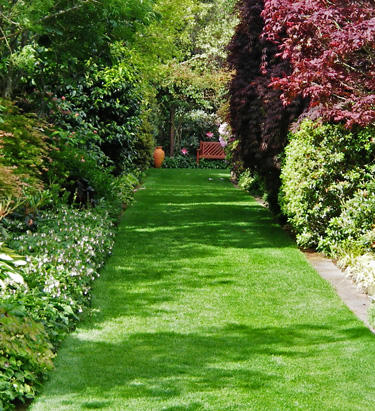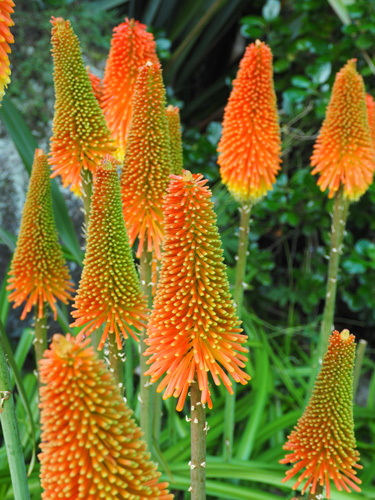Nature's planting time
With cool air and warm, rain-soaked soil that’s easy to dig, autumn is a great time to be outside planting.
When is the best time to plant? The answer depends on what you are planting. It also depends on your climate. In frosty climates, the more cold sensitive plants are best planted in spring. In rainy climates, summer planting is a lot less risky than in drought prone areas. But if there is a best planting season for most plants it has to be autumn, when air temperatures fall and rain starts falling on warm soil.
The reason is simple when you consider what’s going on in the engine room below ground level. It’s all about the roots. Beneath a big healthy tree there is an unseen root volume that matches that height and breadth of the branches and leaves we see above. When you consider the ratio of roots to top growth in a potted nursery plant its plain to see that the roots of a newly planted tree have some catching up to do.
In spring, roots have to pump hard to support rampant foliage and shoot growth above. But in autumn, that top growth slows down as the plant redirects its energy to its roots. So, a tree or shrub planted in autumn is best prepared for the explosion of growth next spring.
This assumes, of course, that a healthy specimen of your plant is actually available in autumn. If a plant is only available in spring or summer (and you have time to pay attention to watering and mulching) it may be better to get it in the ground before it either sells out or sits around in its pot getting stressed all summer. As always, buy plants from a reputable source and check their quality. Bargain bin plants are not always best value for money. Fresh healthy top growth is a sign that all is well below. While March is the ‘official’ start of autumn, you may want to wait until April or May if your summer has been dry.
Autumn is a fantastic time to plant almost anything, especially: trees, shrubs, perennials, spring flowering bulbs, a new hedge, or a new lawn.
Autumn planting projects
Trees and shrubs
If you want a garden that looks great all year round a good rule of thumb is to plant at least half of it in trees and shrubs, including fruit trees. Aim for mainly evergreens, but add a few deciduous trees or shrubs to accent the changing seasons. A well placed tree is an asset that adds value to your property and there is no nicer sun umbrella than the dappled shade of a tree.
Planting tips:
- A tree is a long-term investment. Plant the best quality, best shaped tree you can buy.
- Water thoroughly before planting. Pots can be dunked in a bucket of water until the bubbles stop rising.
- Dig a hole at least twice as wide as the roots.
- Add controlled-release fertiliser into the planting hole.
- Position stakes while you can still see the roots. Ideally use two stakes, one each side of the tree, and tie with flexible ties.
- Gently firm the soil around the roots and water again after planting.
- Add a layer of mulch to retain moisture and block weeds.
A new hedge
Whether you want to sharpen up your garden with a neat border hedge, create privacy or define a boundary with a living wall, autumn is the best time to act. Ideally, start with small to medium plants of an even grade.
TIP: The best shrubs for hedges have small closely packed leaves.
A new lawn
Warm soil and cool moist air is great for lawns too. Lawn seed that’s sown in autumn will quickly germinate and burst into lush green growth. Another plus for autumn sowing; weed growth is less of an issue than it is in spring. Allow a good couple of weeks to get your soil ready for sowing, by which time the weather will hopefully have turned perfect with frequent spells of soft autumn rain.
TIP: Keep lawn shapes simple with crisp clean edges. Clean lines don’t just look great, they’re easy to maintain.
Spring flowering bulbs
March, April and May are the bulb planting months. Be an early bird! Even if you plan to plant towards the end of the season, keep an eye out for bulb stocks arriving in garden centres (from March onwards) so you won’t miss out your favourites. Spring bulbs are among the best flowers for late winter and early spring containers.
TIP: Plant for impact! Even if you have only a few bulbs, they will make more of a statement if you plant in close groupings.
Perennials
Perennials are long-living flowering or foliage plants that provide exciting seasonal interest year after year. Autumn is an excellent time to add to your collection of perennials and the key time lift and divide the ones you already have. Perennials like asters, dayliles, hostas and iris, which grow in clumps, benefit from division every few years. This keeps plants in peak condition, while yielding new ones for planting elsewhere.
TIP: Introduce rhythm and harmony throughout the garden by repeating clumps of the same perennial.

7-Mar-2017

Plant camellias and other trees and shrubs

Plant a corokia hedge

Sow a new lawn or repair the existing one.

Plant tulips and other spring bulbs

Plant perennials such as Kniphofia

